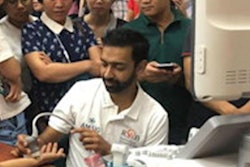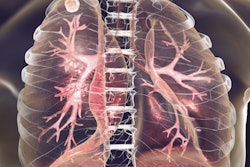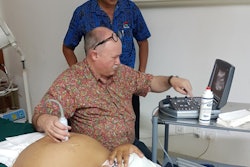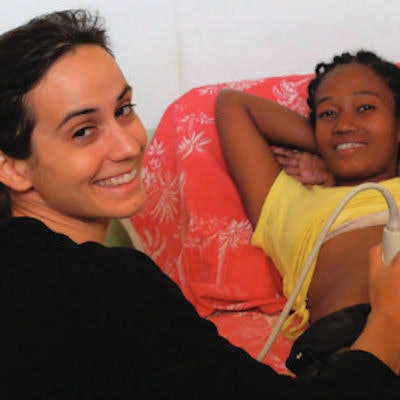
At the end of my hospital training, I wanted to take a break, get out of the hospital for a bit, away from shift work and the constant pressure of performance and efficiency. I dreamt of free time, travel, and adventure. While I procrastinated for months without finding a project that suited me, one day it occurred to me that I was, of course, a radiologist, and above all, a doctor. While becoming superspecialized, I had almost forgotten the fact.
A chance encounter swiftly sealed the deal; one day in March 2015 I learned the Missions Etrangères de Paris (Paris Foreign Missions) had put me in charge of a bush clinic in the village of Bemaneviky, in the north of Madagascar, for nine months of voluntary work. I wanted exoticism -- well I was going to get it!
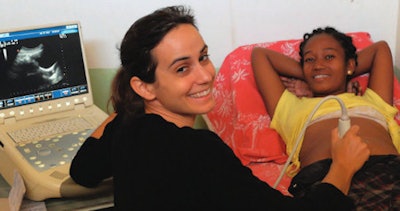 Dr. Anne Fustier scanning a patient. All images courtesy of Dr. Fustier, reproduced from le Quotidien des JFR.
Dr. Anne Fustier scanning a patient. All images courtesy of Dr. Fustier, reproduced from le Quotidien des JFR.The Sambirano is a river that finds its source in the Antsiranana Mountains, winding its way a hundred kilometers before it joins the Mozambique Channel. It irrigates a wide verdant valley running through low mountains. The area is inhabited by more than 150,000 people whose poverty is linked to their extreme isolation. The river, which is not very deep, is only navigable for a few weeks of the year, and the only track along the route is in terrible condition. Practically all of the inhabitants are farmers, growing rice, cocoa, vanilla, and coffee, and living in great deprivation.
Established 35 years ago in the heart of the valley, the Catholic Mission, Don Bosco de Bemaneviky founded nine bush primary schools, a collège-lycée (a middle/high school), as well as a free medical clinic. That's where I worked helped by two nurses.
Ultrasound in a suitcase
The early days were hard: I had to revive my memories of clinical work, familiarize myself with local diseases and medicines without any clinical tools other than urinary test strips, pregnancy tests, a blood glucose meter, and fortunately, best of all, an ultrasound machine. I had actually brought in my suitcase the portable ultrasound machine kindly donated by its manufacturer, Esaote. This extension to my hands became indispensable and helped to compensate for my lack of clinical experience.
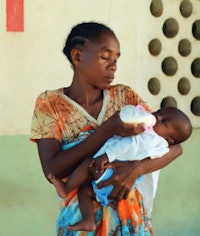 Ultrasound scans proved a winner among new parents.
Ultrasound scans proved a winner among new parents.Armed with three probes, I imaged my patients from every angle, much to their amazement. I was lucky because their typical lean physique made them highly echogenic and they never had a train to catch; waiting for two hours for there to be enough sunshine for me to start up my ultrasound unit didn't bother them, nor did returning home empty-handed on rainy days. The ups and downs of solar panels ...
Except for a few x-ray images transported in zebu-drawn carts (local version of an ambulance) by canoe or by bike, and which were barely readable, my radiological toolbox was limited to a single ultrasound machine. The latter was a great success among pregnant women, though unfortunately the level of obstetric care in the bush meant my images were not of great utility. At least I got to experience the parents' astonished and happy faces.
For musculoskeletal imaging, the tests were less of a pleasure but clearly more useful. I was able to delineate and drain infectious fluid collections in soft tissue, and diagnose septic arthritis secondary to a penetrating injury.
Rife with bilharzia
The abdominal probe proved extremely useful in cardiology, allowing me to confirm several cases of heart failure and pericarditis. But of course the greatest benefits were seen in abdominal pelvic ultrasound. Beyond the usual pathologies encountered in city practice, I quickly realized the Sambirano valley, which is crossed by countless streams, rice fields, and marshes, was rife with bilharzia. This pathology was so frequent and so unrecognized that most affected patients did not mention their hematuria to me. I discovered the truth incidentally through an abdominal ultrasound exam. Bladder wall thickening and vegetations of varying size, degree of calcification, and vascularization were clearly visible. Renal damage was less obvious, in general limited to a mild pyelocalyceal dilatation.
Alerted, I systematically questioned my patients along these lines, strengthening my diagnosis with urinary test strips and ultrasound, which I performed if in the slightest doubt. I was frightened by the results: around 20% of my patients were probably infected with bilharzia. A few diagnoses were confirmed biologically. In most cases, this diagnosis was retrospective -- the macroscopic hematuria ceased in the week following treatment, ultrasound improvement was clear after two weeks. I liberally prescribed my patients with praziquantel, conscious, unfortunately, of its fleeting efficacy in the absence of any wide-scale action undertaken by the health authorities.
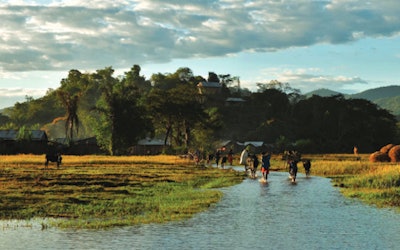 The Sambirano Valley is rife with bilharzia.
The Sambirano Valley is rife with bilharzia.The other pathologies encountered were mainly parasitical or nonparasitical infectious diseases: diarrhea, sexually transmitted infections, malaria, tuberculosis, dental and skin infections, etc.
I was also lucky in having a pharmacy, one that was simple but well-stocked for the region, which allowed me to treat my patients immediately whenever possible. Nevertheless, the lack of resources was evident, which led us to adopt the motto: "Save, recycle, invent." This is why I have such funny memories from the homemade milk pump cobbled together from a funnel and a bike pump, to the painstaking process of milk-fabrication for undernourished newborns on a shoestring budget. Also, a memorable nighttime scene of suprapubic catheterization done by headlamp (no electric? no pediatric urinary catheter? shame!), and that's the least of it ...
Deep fulfillment
Altogether, this experience was deeply fulfilling. I was able to grasp the extreme usefulness of ultrasound in bush medical practice as well as its feasibility. My machine withstood several days of transit in temperatures of 35° Celsius on rough, cratered tracks, then the extreme humidity of the rainy season. Even the rats, which several times ransacked my pharmacy -- I found their corpses next to the empty pill packets! -- spared the cables.
I have come back convinced of the benefits of ultrasound in humanitarian medical practice. Several types of action are feasible in Madagascar, whether this involves the donation of equipment, the training of local doctors, or periodic ultrasound programs.
I won't deny that often I had a sense of powerlessness when going about my daily work, sometimes painfully so when it involved children or pathologies that are curable in France. However, the joy of several victories won is so great that it wipes the slate clean.
The staggering social and economic disparity made me sometimes feel as though I was on another planet or had travelled to a different era, but it also offered me a highly liberating step back from my life and our society. And above all, in this far-off country, I had marvelous, enriching encounters that will change my life forever. Travel's a great education, isn't it?
Dr. Anne Fustier is a general radiologist at Hôpital Pitié-Salpêtrière in Paris.
Editor's note: This is an edited translation of an article published in French on 17 October 2016 by le Quotidien des JFR (Journées Francophones de Radiologie), the daily newspaper of the JFR. Translation by Frances Rylands-Monk.
The comments and observations expressed herein do not necessarily reflect the opinions of AuntMinnieEurope.com, nor should they be construed as an endorsement or admonishment of any particular vendor, analyst, industry consultant, or consulting group.




